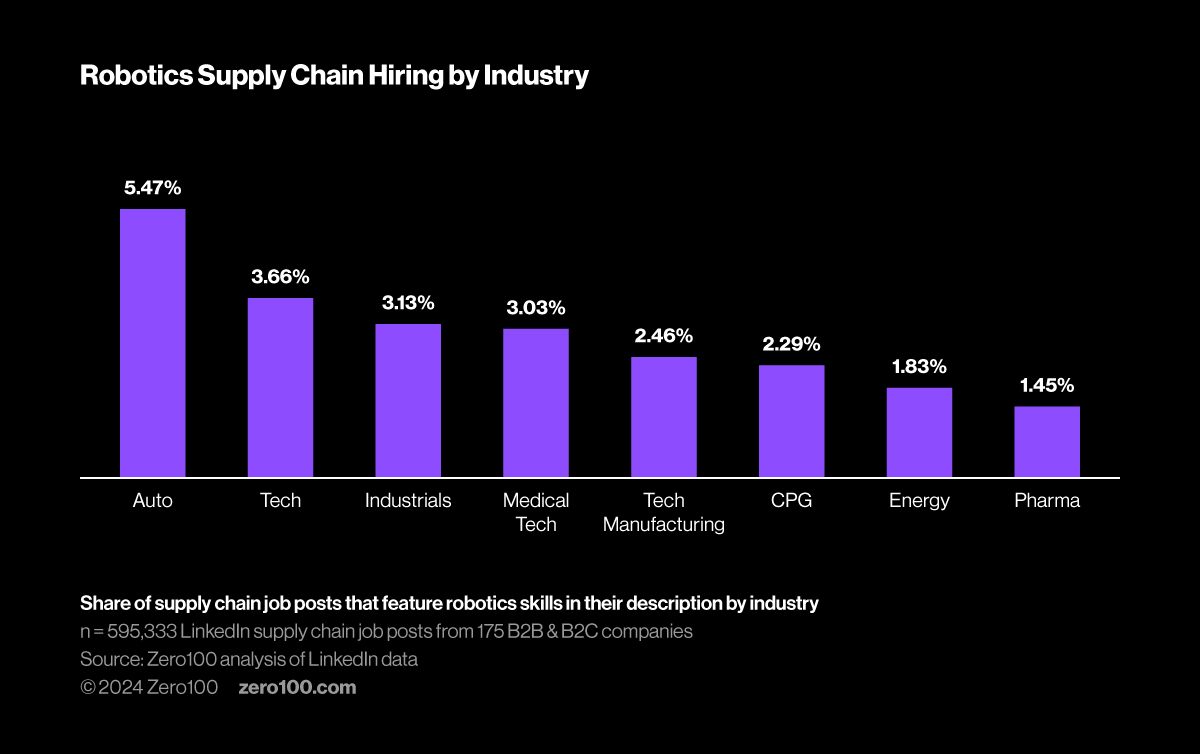

Robotics Skills: Powering the Future of Supply Chain
Despite the widespread interest in, experimentation with, and implementation of robotics across industries, particularly within manufacturing, mentions of robotics skills only appear in 2% of all supply chain job posts on LinkedIn.
Key Takeaways
-
1
Just 2% of supply chain job posts from 175 large B2B & B2C companies mention robotics skills. This low figure marginally rises to 3% when looking specifically at manufacturing job posts.
-
2
The top three companies for robotics hiring in supply chain are: General Motors (16% of jobs), Honda (15%), and P&G (12%).
-
3
Auto companies feature robotics skills more frequently than other industries (5.5% of jobs on average). This is closely followed by technology (3.7%) and industrials (3.1%).
A quick Google of “robotics in supply chain” underlines this skill’s importance in autonomous manufacturing and the future of supply chain. Robots are widely used in manufacturing across industries. They are vital in warehouses and distribution centers where picking times are reduced by half with mobile robots. And robots are even easier to access and acquire as prices have come down by 50% in the last decade (with a further 50% drop by 2025). Robots-as-a-service for both hardware and software is another even more cost-effective option to consider. Successfully using robots requires the right people with the right skills in your supply chain to maximize productivity and output.
Despite the widespread interest in, experimentation with, and implementation of robotics across industries, mentions of robotics skills only appear in 2% of supply chain job posts on LinkedIn – an equal split across B2B and B2C companies. In addition to looking for mentions of robotics, we also looked for robotic process automation (RPA) and additive manufacturing. Given the heavy automation and machinery involved in manufacturing vehicles, it’s no surprise that the auto industry has the largest share of robotics skill mentions in job posts at 5%. They are followed by technology (4%), industrials (3%), and medical technology (3%).
The company with the most mentions of robotics skills in supply chain job posts is General Motors (GM). They have made a big push to incorporate robotics innovation into their hiring and internal culture – 16% of their supply chain job posts mention robotics skills (23% for autonomous), most of which are in manufacturing jobs, with some in product development. They use robots to increase efficiency and reduce risk during repetitive tasks and use cobots (collaborative robots) to improve worker productivity and safety, including a partnership with NASA to develop a humanoid robot. But the confluence of robots and talent began in 2019 with 3D printing. GM encouraged “budding additive enthusiasts” by opening the Additive Innovation Lab (AIL), a 4,000 sq ft facility. The next year, in 2020, the Additive Industrialization Center (over 3x larger than the AIL) was opened specifically for polymer and metal additive manufacturing. This center now lists over 5,000 unique parts. 3D printing enables GM to print custom tools for plant workers, making their jobs safer and more productive. To further robotics usage, buy-in, and worker happiness, GM introduces additive machines into plants where 3D printing “enthusiasts” make themselves known.
The company that ranks third for most mentions of robotics skills in job posts falls outside the top four industries (auto, technology, industrials, and medical technology) we detail above, however. 12% of Procter & Gamble’s (P&G) supply chain jobs mention robotics, which is 2.4x more than the next company, the Estée Lauder Companies. At P&G, cobots streamline manufacturing processes such as assembling and packaging products. They create machines and grippers that can handle bottles and tubes of a variety of shapes and sizes (which change frequently) to get them into increasingly complex packaging.
Another frontrunner, Applied Materials, a company that provides equipment and software for chip manufacturing, has been investing in robotics technology for various applications in its manufacturing processes, including wafer handling, material transfer, and inspection. This is reflected in their job posts – 10% of their job listings mention robotics skills and 6% mention autonomous skills.

The examples above illustrate how leaders are embedding robotics skills into their operations. To further help the Community advance its robotics capabilities, Zero100 is launching a robotics benchmarking exercise with the goal of gaining insights into how many robots are installed and running per 10,000 employees across organizations. The output will be anonymized and shared with participants as an average across all participating companies. If you have an interest in participating in this exercise or in learning more about hiring for robotics skills, please reach out to our Head of Research Analytics, Cody.Stack@zero100.com.
Methodology
Zero100’s proprietary data and analytics are a combined effort between our data scientists and research analysts. We provide data-first insights matched with our own research-backed points of view and bring this analysis to life via real-world case examples being led by supply chain practitioners today.
For this study, we looked at 2.8 million LinkedIn job posts from 175 B2B and B2C companies. Our analysis categorizes listings based on mentions of specific digital skills within job titles and descriptions.